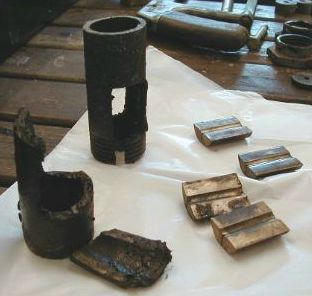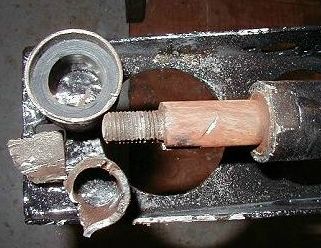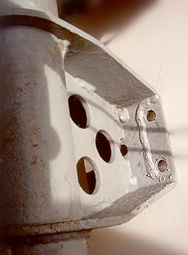Brakes ...
Now I am involved in getting the braking system operational again, the first decision is do we use or try to use any of the old brake pipes? No! That has sorted that out, the brake pipes, that is the copper ones and the three flexible hoses are all showing their age, so all are to be replaced. Having had a look at the set the Octagon Car Club are offering I realised that some of the ends were different to mine, i.e. female ends where I expected male ends and vice versa, so a new set are being provided and when I have them I will check them against Flivver. Ken will have it correct, I feel sure.
Early MG TA Brake Fittings and Pipes
This part is for those of us that have the early type TA's, that is those with the narrow wings and wide tank. I will not attempt to give the chassis number that this information applies to as I am not sure myself. However my chassis numbers are 0418 and 1237 and as the piping and fittings are identical on these two cars then it should be a safe bet that all of the cars between these chassis numbers should be the same!
The reason for including this note is that brake pipe sets provided by some suppliers are not “apparently” correct, that is the pipes have the wrong ends for the application they are required for. So here is my version of the pipes and fittings for these early TA's: All of the pipes and therefore the fittings are of the flared type and are not compression fittings!
Starting from the master cylinder there is a fitting 6372/4 that is screwed into the rear of the cylinder and has two female outlets. The outlet facing out from the chassis is connected to the front offside brake cylinder flexible pipe via a pipe 40" long with a protective coil around it for the whole of its length. The outlet facing into the chassis is connected to the male 3-way connector 6020/4 that is bolted to the nearside chassis via a pipe 29" long with a protective coil around it for the whole of its length. The forward outlet goes to the front nearside brake cylinder flexible pipe via a pipe 30" long with a protective coil around it for the whole of its length. An interesting observation here is that the nearside pipe goes through a hole in the chassis so only a short length of the pipe is observed from the outside, whereas the offside one does not. I can see no reason for it not going through the chassis and it would clear the wheel easily when a full lock is applied, mine just touches the brake pipe on full lock. The final rear facing male part of connector 6020/4 is connected to the flexible pipe fitting on the cross member by the differential via a pipe 74" that has no need to be protected by an armoured coil as it is routed via the inside of the chassis rail.
The flexible brake hose from the cross member then goes to a 3-way connector 241/4 that is bolted to the differential. This fitting is a female, male, male fitting, the flexible hose is screwed into the female thread and the other males are for the two rear brake connections. The one to the rear offside is 16" long and protected by an armoured coil for the whole of its length and the one to the rear nearside is 29" and again protected for the whole of its length by an armoured coil. Both of these pipes are screwed into the rear brake cylinders by a banjo fitting 2949/4, this means that to fit the banjo fittings the pipes must have a male fitting to go into the female banjo fitting and consequently the other ends have a female nut on them. Incidentally both of these pipes run to the rear of the rear axle straps not inside as they would be crushed if you gave the suspension a true test of its capabilities.
If anyone knows of any mistakes in this section of the text would they please let me know so I can make the neccessary corrections. I can also put right any faults that I may have transferred to my rebuild project TA 1237.
| 



